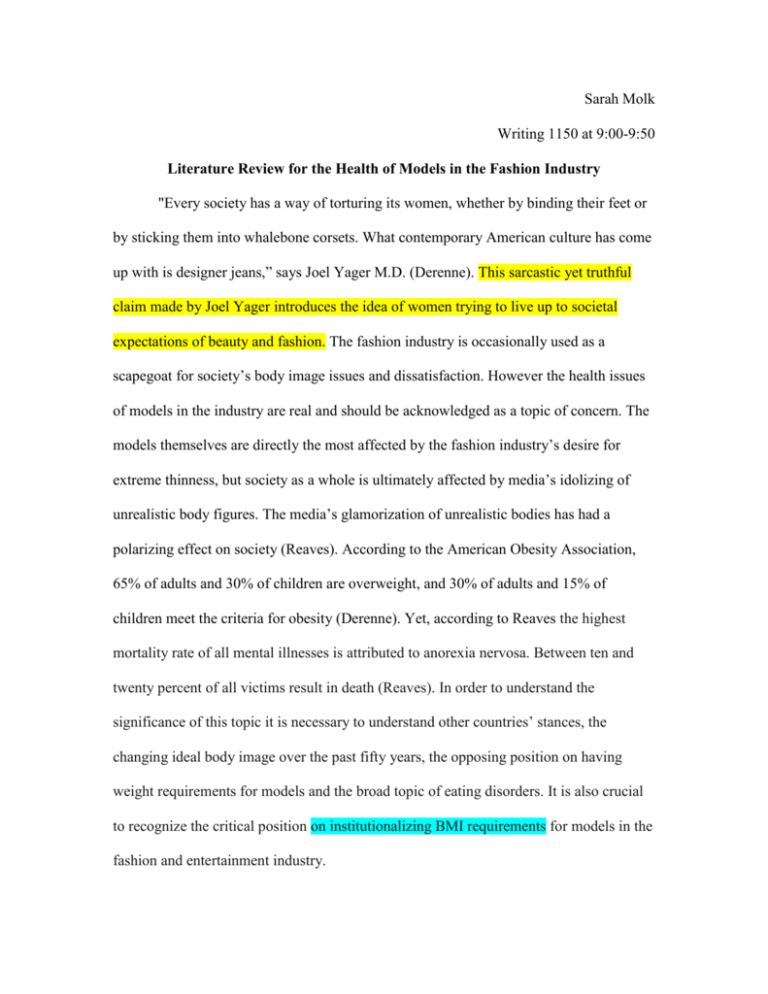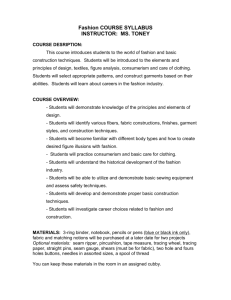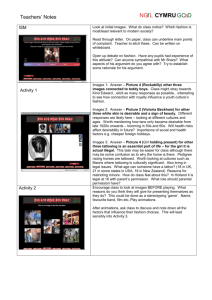Basic Health Indicators of models compared to
advertisement

Sarah Molk Writing 1150 at 9:00-9:50 Literature Review for the Health of Models in the Fashion Industry "Every society has a way of torturing its women, whether by binding their feet or by sticking them into whalebone corsets. What contemporary American culture has come up with is designer jeans,” says Joel Yager M.D. (Derenne). This sarcastic yet truthful claim made by Joel Yager introduces the idea of women trying to live up to societal expectations of beauty and fashion. The fashion industry is occasionally used as a scapegoat for society’s body image issues and dissatisfaction. However the health issues of models in the industry are real and should be acknowledged as a topic of concern. The models themselves are directly the most affected by the fashion industry’s desire for extreme thinness, but society as a whole is ultimately affected by media’s idolizing of unrealistic body figures. The media’s glamorization of unrealistic bodies has had a polarizing effect on society (Reaves). According to the American Obesity Association, 65% of adults and 30% of children are overweight, and 30% of adults and 15% of children meet the criteria for obesity (Derenne). Yet, according to Reaves the highest mortality rate of all mental illnesses is attributed to anorexia nervosa. Between ten and twenty percent of all victims result in death (Reaves). In order to understand the significance of this topic it is necessary to understand other countries’ stances, the changing ideal body image over the past fifty years, the opposing position on having weight requirements for models and the broad topic of eating disorders. It is also crucial to recognize the critical position on institutionalizing BMI requirements for models in the fashion and entertainment industry. Body Image in Magazines and its Progress over the past 50 years According to Agrell current studies show that fashion models have gotten thinner during the 1980s and 1990s then in previous years. There has also been an increase of full body image advertisements in magazines between the 1960s and 1990s (Agrell). Cosmopolitan, Glamour, and Vogue have all displayed revealing advertisements with men and women that initiated controversy (Agrell). One being, anorexic’s use of fashion magazines to feed their self -deprivation. People with eating disorders look at the emaciated models and yearn for their famished looking bodies. They relate the advertisements to their own bodies in order to satisfy their body dimorphic issues (Reaves). Magazines are criticized for what seems like promotion of a self -deprived lifestyle. Current studies show that women seem to be more negatively affected after viewing photographs with thin models then average sized models, plus sized models, and inanimate objects (Groesz). The positive associations with being thin can be hidden, but sometimes these messages are blatant and vary obvious. Certain items seem appealing only if you are thin enough or have the body type of the model displaying the item (Ahern). Such as a specific designer jean, or any apparel that is form fitted. All of these studies are meant to exemplify the disadvantages of using thin models in advertisements and media versus the use of women with average bodies. Basic Health Indicators of models compared to average women A basic health indicator is body mass index, which is a common measurement to determine overweight and underweight. According to World Health Organization (WHO) guidelines, adults are underweight if they have BMI’s of less than 18.5 (Thin Fashion Models). Fashion designers and others involved in the fashion industry agree that a great number of models are technically underweight, which makes them appealing to their employers. "They are not average," Kelly Cutrone, owner of the fashion-show production company People's Revolution, says of fashion models. "They are naturally thin and have incredibly long legs compared to the rest of their body. Their eyes are wide set apart. Their cheekbones are high"(Thin Fashion Models). The increasing obesity rates in America and inconsistent focus on having a picture perfect body, illustrates the widening of the gap between the average woman and a fashion model’s weight (Derenne). Models are becoming thinner then the once ideal curvaceous figure such as Marilyn Monroe, and ordinary women are becoming heavier due to various attributions such as lack of exercise and unhealthy eating habits (Dittmar). Eating disorders and their affects on fashion models and average women Fashion models are distinguished from average people by their stick like figures and ability to display clothing the way the designer intended it to look. However, according to Reaves the emaciated look of models is becoming an ideal of female beauty, not only in the eyes of a fashion designer. It is not uncommon for women with money and high social status to undergo mental and physical pain to achieve the runway model look (Reaves), while adolescents as young as nine years old have already been on at least one diet and seriously consider the fat content of food (Harrison). The fashion industry might not be to blame for the youth’s issues with food, however media and celebrity rolemodels might be an influential factor. The obsession to control restriction food and constant pressure of maintaining a weight of 80 pounds pushed a model to death. In November 2006, Brazilian fashion model Ana Carolina Reston died in Sao Paulo from an infection related to anorexia nervosa (Other Countries’). The association between eating disorders and fashion models has always been a sensitive subject to the fashion industry. There are many arguments to support and refute the coincidence between the numbers of fashion models with eating disorders. Other countries’ stances on thin fashion models Ana Carolina Reston’s death from complications of a kidney infection due to anorexia nervosa made international headlines instantly. In January 2007 as a response to this horrific event the management of Sao Paulo’s fashion week placed BMI restrictions of no lower then 18(Other Countries’). India is another country that is becoming more aware of the health issues that arise from starvation. In September 2008 the Indian Health Minister, Anbumani Ramadoss showed his disproval of the fashion industry’s affects on young women by mentioning the risk of osteoporosis, which is a decrease in bone mass that can be caused by deficiencies in calcium and other minerals. A cause of this is extreme dieting for long periods of time (Other Countries’). Israel is in the process of reducing the number of eating disorder cases by trying to pass legislation that would set a minimum BMI for models (Other countries’). Adi Barkan, an Israeli fashion photographer made an arrangement with multiple retail stores to not display underweight models in their advertisements (Other Countries’). Barkan refuses to photograph models that appear unhealthy. Madrid takes a more direct approach by requiring models to have a BMI of at least 18 to appear in its fashion week. A 5'9" model, for example, would have to weigh at least 122 pounds (Thin Models). France took direct action and passed a law in April 2008 that not only affects the models, but the fashion magazines as well. It is a crime to promote thinness through the Internet, magazines, or any other advertisements (Agrell). Digital Manipulation of Fashion Models Fashion magazines typically see no problem with their standard tweaking of the models in their photographs. The occasional enhancement of ordinary blue eyes into extraordinary sapphire, retouching teeth to perfection, and slenderizing of already lean legs, seem like normal alterations to a fashion photographer (Betts). Occasionally these tweaks are condemned as a “dark art” because they can completely change the look of the model (Betts). Reaves argues that digital manipulation is an art, but it is one that has psychological consequences for an audience that questions principle of artistic freedom against the principle of protecting public health (Reaves). The manipulated photos could easily influence readers who are possible eating disorder victims. They will be striving to achieve a body that is a “digital mirage”, says Reaves. In a recent program about adolescent health Tyra Banks, a celebrity model, told Oprah, “It’s all retouched. We don’t do a lot during photo shoots now. They’ll be like ‘Tyra, suck it! No! Just retouch it!’ Can’t you just get this? I don’t want to suck my stomach in” (Reaves). Models admit to this digital manipulation like it is no big deal, yet some of the public strives for the obviously unrealistic physique. The question comes down to if digital manipulation should be accepted in the fashion industry if the magazines, photographers and models admit to using it? Critical position on BMI Requirements New Republic senior editor Michelle Cottle writes: “The fashion industry's goal has never been to make women feel good about themselves.... Rather, the fashion industry's raison d'être is to sell glamour--to dazzle women with fantastical standards of beauty that...are, by design, far beyond the reach of regular people” (Thin Models). In other words, the fashion industry is not meant to appeal to the average person, it is supposed to be a fantasy of glamour and beauty that is unachievable. The fashion designers believe institutionalizing a BMI requirement takes value away from their products and imposes on their freedom to express themselves as a designer (Thin Models). Critics also argue that banning models below a certain weight could be looked at as discrimination, especially when some are naturally thin (Thin Models). Unhealthy weight is a growing problem on both ends of the scale, but people cannot be “legislated out of being too thin”, just as they cant be for being too fat (Agrell). There is a two way street and one side cannot be condemned for being unhealthy when the other has health concerns as well. Some critics agree that action should be taken, but they feel it should be voluntary and designers and models should be apart of the process (Thin Models). Diane von Furstenburg, a notable fashion designer and president of the Council of Fashion Designers of America (CFDA), thinks that the CFDA should “promote health as a part of beauty”, instead of setting specific rules and requirements (Thin Models). Conclusion The current research is showing a large correlation between the thinness of fashion model’s negative affect on an average woman’s perception about herself. It is clear that the unrealistic images of these models is contributing to women having body issues, which occasionally result in eating disorders such as anorexia nervosa and bulimia. There is also strong evidence of digital manipulation of models for print ads and other photographs. Magazines have increased their use of full body images and retouching of slight imperfections. However there is a lack of information on the truth behind models and their opinions and struggles of staying so thin. The extreme dieting and rumored tricks of being a fashion model have not been uncovered. Celebrity fashion models talk about rigorous workouts and strict dieting, but it seems there is more behind closed doors. As far as print advertisements, the improvement of technology will only increase the use of retouch and altering the unthinkable. The future of print advertisements according to fashion will be designed to perfection, meaning the models will not need to be ultra thin or have any specific qualities because the retouching will be so exact that no one will be able to tell the difference. The runway fashion industry will still have face-to-face models, but how long will the extreme thin be in style? What will fashion designers do if the public starts to reject the super skinny look and demand a more realistic figured model? Citations 1. Agrell, S. (2008). Thin police. CMAJ: Canadian Medical Association Journal, 179(2), 204. Retrieved September 28, 2011, from EBSCOhost. 2. Ahern, A. Bennett, K. Hetherington, M. (2008): Internalization of the Ultra-Thin Ideal: Positive Implicit Associations with Underweight Fashion Models are Associated with Drive for Thinness in Young Women, Eating Disorders, 16:4, 294-307. Retrieved September 29, 2011, from Google Scholar. 3. Betts, K. (2003, March 9). The Man who makes the Picture Perfect. New York Times, Section 9, pp. 1,8. Retrieved September 30, 2011, from Research Library. 4. Derenne, J. (2006, May-June). Body Image, Media, and Eat Disorders. Media Column. Retrieved September 29, 2011, from Google Scholar. 5. Dittmar, H., Halliwell, E., & Stirling, E.. (2009). UNDERSTANDING THE IMPACT OF THIN MEDIA MODELS ON WOMEN'S BODY-FOCUSED AFFECT: THE ROLES OF THIN-IDEAL INTERNALIZATION AND WEIGHT-RELATED SELF-DISCREPANCY ACTIVATION IN EXPERIMENTAL EXPOSURE EFFECTS. Journal of Social and Clinical Psychology, 28(1), 43-72. Retrieved September 29, 2011, from Research Library. (Document ID: 1642953581). 6. Groesz, L. M., Levine, M. P. and Murnen, S. K. (2002), The effect of experimental presentation of thin media images on body satisfaction: A metaanalytic review. International Journal of Eating Disorders, 31: 1–16. Retrieved September 28, 2011 from EBSCOhost. 7. Harrison, K. (2001). Ourselves, our bodies: Thin-ideal media, self-discrepancies, and eating disorder symptomatology in adolescents. Journal of Social and Clinical Psychology, 20(3), 289-323. Retrieved September 29, 2011, from Research Library. (Document ID: 84614048). 8. "Other Countries' Stances on the Issue of Thin Models." (2007,March 9). Issues & Controversy On File. Retrieved September 29, 2011from Issues & Controversy database. 9. Reaves, S., Hitchon, J., Park, S., & Yun, G. (2004). If Looks Could Kill: Digital Manipulation of Fashion Models. Journal of Mass Media Ethics, 19(1), 56-71. Retrieved September 29, 2011from EBSCOhost. 10. "Thin Fashion Models." (2009, March 9). Issues & Controversies On File. Retrieved September 28, 2011 from Issues & Controversies database.








